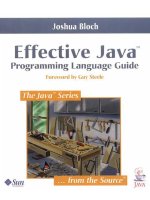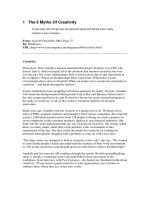Tài liệu The Go Programming Language Phrasebook pdf
Bạn đang xem bản rút gọn của tài liệu. Xem và tải ngay bản đầy đủ của tài liệu tại đây (2.34 MB, 276 trang )
www.it-ebooks.info
The Go Programming
Language
P H R A S E B O O K
David Chisnall
DEVELOPER’S
LIBRARY
Upper Saddle River, NJ • Boston • Indianapolis • San Francisco
New York • Toronto • Montreal • London • Munich • Paris • Madrid
Cape Town • Sydney • Tokyo • Singapore • Mexico City
www.it-ebooks.info
Many of the designations used by manufacturers and sellers to distinguish their
products are claimed as trademarks. Where those designations appear in this book,
and the publisher was aware of a trademark claim, the designations have been printed with initial capital letters or in all capitals.
The author and publisher have taken care in the preparation of this book, but make
no expressed or implied warranty of any kind and assume no responsibility for errors
or omissions. No liability is assumed for incidental or consequential damages in connection with or arising out of the use of the information or programs contained herein.
The publisher offers excellent discounts on this book when ordered in quantity for
bulk purchases or special sales, which may include electronic versions and/or custom covers and content particular to your business, training goals, marketing focus,
and branding interests. For more information, please contact:
U.S. Corporate and Government Sales
(800) 382-3419
For sales outside the United States, please contact:
International Sales
Visit us on the Web: informit.com/aw
Library of Congress Cataloging-in-Publication Data:
Chisnall, David.
The Go programming language phrasebook / David Chisnall.
p. cm.
Includes index.
ISBN 978-0-321-81714-3 (pbk. : alk. paper) — ISBN 0-321-81714-1 (pbk. : alk.
paper)
1. Go (Computer program language) 2. Computer programming. 3. Open source
software. I. Title.
QA76.73.G63C45 2012
005.3—dc23
2012000478
Copyright © 2012 Pearson Education, Inc.
All rights reserved. Printed in the United States of America. This publication is protected by copyright, and permission must be obtained from the publisher prior to any
prohibited reproduction, storage in a retrieval system, or transmission in any form or
by any means, electronic, mechanical, photocopying, recording, or likewise. To obtain
permission to use material from this work, please submit a written request to
Pearson Education, Inc., Permissions Department, One Lake Street, Upper Saddle
River, New Jersey 07458, or you may fax your request to (201) 236-3290.
ISBN-13: 978- 0-321-81714-3
ISBN-10: 0-321-81714-1
Text printed in the United States on recycled paper at Edwards Brothers Malloy in
Ann Arbor, Michigan.
First printing: March 2012
Editor-in-Chief
Mark Taub
Acquisitions Editor
Debra Williams
Cauley
Marketing
Manager
Stephane Nakib
Managing Editor
Kristy Hart
Project Editor
Anne Goebel
Copy Editor
Gayle Johnson
Publishing
Coordinator
Andrea Bledsoe
www.it-ebooks.info
Cover Designer
Gary Adair
Senior Compositor
Gloria Schurick
Table of Contents
1 Introducing Go
1
Go and C
Why Go?
Goroutines and Channels
Selecting a Compiler
Creating a Simple Go Program
The Go Type System
Understanding the Memory Model
1
4
7
10
13
14
16
2 A Go Primer
The Structure of a Go Source File
Declaring Variables
Declaring Functions
Looping in Go
Creating Enumerations
Declaring Structures
Defining Methods
Implementing Interfaces
Casting Types
21
23
26
29
32
35
37
39
42
47
3 Numbers
Converting Between Strings and Numbers
Using Large Integers
Converting Between Numbers and Pointers
51
52
54
56
4 Common Go Patterns
61
www.it-ebooks.info
iv
Contents
Zero Initialization
Generic Data Structures
Specialized Generic Data Structures
Implementation Hiding
Type Embedding
62
67
69
72
75
5 Arrays and Slices
Creating Arrays
Slicing Arrays
Resizing Slices
Truncating Slices
Iterating Over Arrays
79
81
83
85
87
88
6 Manipulating Strings
Comparing Strings
Processing a String One Character at a
Time
Processing a Partial String
Splitting and Trimming Strings
Copying Strings
Creating Strings from Patterns
91
92
Matching Patterns in Strings
7 Working with Collections
Creating a Map
Storing Unordered Groups of Objects
Using Lists
Defining New Collections
www.it-ebooks.info
94
96
98
102
102
104
107
108
111
112
114
Contents
8 Handling Errors
Deferring Cleanup
Panicking and Recovering
Returning Error Values
Error Delegates
117
118
121
125
127
9 Goroutines
Creating Goroutines
Synchronizing Goroutines
Waiting for a Condition
Performing Thread-Safe Initialization
Performing Actions in the Background
Communicating Via Channels
Using Multiple Channels
131
131
134
137
140
142
144
148
10 Concurrency Design Patterns
Timing Out Connections
Aliased xor Mutable
Share Memory by Communicating
Transactions by Sharing Channels
Concurrent Objects
Implementing Futures in Go
Coalescing Events
151
152
154
156
159
162
164
166
Map Reduce, Go Style
11 Dates and Times
Finding the Current Date
Converting Dates for Display
www.it-ebooks.info
168
175
176
177
v
vi
Contents
Parsing Dates from Strings
Calculating Elapsed Time
Receiving Timer Events
179
180
181
12 Accessing Files and the Environment
Manipulating Paths
Reading a File
Reading One Line at a Time
Determining if a File or Directory Exists
Checking Environment Variables
183
184
186
188
190
192
13 Network Access
Connecting to Servers
Distributing Go
Serving Objects
Calling Remote Procedures
195
196
199
204
206
14 Web Applications
Integrating with a Web Server
Connecting to Web Servers
Parsing HTML
Generating HTML
207
208
211
213
216
15 Interacting with the Go Runtime
Finding the Type of a Variable
Finalizing Structures
Copying Arbitrary Types
Constructing Function Calls
Calling C Functions
219
220
223
226
228
230
www.it-ebooks.info
Contents
16 Distributing Go Code
Installing Third-Party Packages
Creating Packages
Documenting Your Code
Staying Up to Date
233
234
236
240
241
17 Debugging Go
Using a Debugger
Misunderstanding Memory Ordering
Spotting Concurrency Bugs
Restricting Behavior
Building Unit Tests
243
243
247
249
252
257
Index
259
www.it-ebooks.info
vii
This page intentionally left blank
www.it-ebooks.info
About the Author
David Chisnall is a freelance writer and consultant.
While studying for his PhD, he cofounded the
Étoilé project, which aims to produce an opensource desktop environment on top of GNUstep,
an open-source implementation of the OpenStep
and Cocoa APIs. He is an active contributor
to GNUstep and is the original author and
maintainer of the GNUstep Objective-C 2
runtime library and the associated compiler
support in the Clang compiler. He is also a
FreeBSD committer working various aspects of
the toolchain, including being responsible for the
new C++ stack.
After completing his PhD, David hid in academia
for a while, studying the history of programming
languages. He finally escaped when he realized
that there were places off campus with an
equally good view of the sea and without
the requirement to complete quite so much
paperwork. He occasionally returns to collaborate
on projects involving modeling the semantics of
dynamic languages.
When not writing or programming, David enjoys
dancing Argentine tango and Cuban salsa,
playing badminton and ultimate frisbee, and
cooking.
www.it-ebooks.info
Acknowledgments
The first person I’d like to thank is Mark
Summerfield, author of Programming in Go:
Creating Applications for the 21st Century. If
you finish this book and want to learn more, I’d
recommend you pick up a copy. Mark was the
person responsible for making me look at Go in
the first place.
The next person I need to thank is Yoshiki
Shibata. Yoshiki has been working on the
Japanese translation of this book and, in doing
so, has sent me countless emails highlighting
areas that could be improved. If you enjoy
reading this book then Yoshiki deserves a lot of
the credit.
Finally, I need to thank everyone else who was
involved in bringing this book from my text
editor to your hands. A lot of people have
earned some credit along the way. In particular,
Debra Williams-Cauley, who masterminded the
project, and Anne Goebel, who shepherded the
book from a draft manuscript to the version you
now hold.
www.it-ebooks.info
1
Introducing Go
When learning a new language, there are three
things that you need to understand. The first
and most important is the abstract model that
the language presents. The next is the concrete
syntax. Finally, you need to learn your way
around the standard libraries and the common
idioms of the language.
This chapter will look at the abstract model
that Go presents to programmers. If you want
to dive straight into real examples, skip to the
next chapter, which covers the concrete syntax.
The rest of the book will cover highlights from
the Go standard library and the various idioms
that you will find common in Go code.
Go and C
In the late ’60s, a small team at the Bell Telephone
Laboratories wrote a simple operating system
called UNICS, a very lightweight system inspired
www.it-ebooks.info
2
CHAPTER 1: Introducing Go
by the MULTICS project, on the PDP-7 minicomputer
that they had access to. When they wanted to
port it to another system, they had to rewrite
all of the code, which was written in PDP-7
assembly language.
To make the transition easier, they wanted to be
able to share as much code as possible between
different versions. They needed a language that
was sufficiently low-level that a simple compiler
(the only kind that existed in the ’60s) could
generate efficient machine code from it, yet
which hid most of the irrelevant details of the
target machine. BCPL was close, but it was too
complex in some areas and lacked some required
features in others.
Dennis Ritchie created the C programming
language as a derivative of BCPL, and eventually
most of the PDP-11 version of UNIX was
rewritten in it. When UNIX was ported to the
VAX, they just needed to retarget the compiler
and write a small amount of very low-level
assembly code. The majority of the system
could be recompiled without modification.
Since its initial public release in 1978, C has
become a very popular language. It is the de
facto standard low-level language for programming
these days, and it even finds use in a significant
amount of application development.
The point of a low-level language is to provide
an abstract machine model to the programmer
that closely reflects the architecture of the
www.it-ebooks.info
Go and C
concrete machines that it will target. There is no
such thing as a universal low-level language: a
language that closely represents the architecture
of a PDP-11 will not accurately reflect something
like a modern GPU or even an old B5000
mainframe. The attraction of C has been that,
in providing an abstract model similar to a PDP11, it is similar to most cheap consumer CPUs.
Over the last decade, this abstraction has
become less like the real hardware. The C
abstract model represents a single processor
and a single block of memory. These days, even
mobile phones have multicore processors, and
a programming language designed for singleprocessor systems requires significant effort
to use effectively. It is increasingly hard for
a compiler to generate machine code from C
sources that efficiently uses the resources of the
target system.
In 2007, Robert Griesemer, Pike, and Ken
Thompson began work on a new language.
Thompson had both been instrumental in the
creation of C and Pike had worked on it later
at Bell Labs, being members of the original
UNIX team that drove the development of C.
The aim of Go, their new language, was to fill
the same niche today that C fit into in the ’80s.
It is a low-level language for multiprocessor
development. Experience with C taught them
that a successful systems programming language
ends up being used for application development,
so Go incorporates a number of high-level
www.it-ebooks.info
3
4
CHAPTER 1: Introducing Go
features, allowing developers to use it for things
like web services or desktop applications, as well
as very low-level systems.
Both Pike and Thompson worked on Plan
91 , a system designed to be a “better UNIX
than UNIX.” Plan 9 eventually gave birth to
the Inferno distributed operating system. For
Inferno, Pike created the Limbo programming
language. If you’ve used Limbo, you will find
a lot of ideas very similar. The module system,
channel-based communication, garbage collection,
much of the type system, and even a lot of the
syntax in Go are inherited directly from Limbo.
The reference implementation of Go is based on
the Plan 9 compiler toolchain.
If you come from C, then many things in Go
will seem familiar, but some will seem strange.
As a trivial example, variable declarations in
Go usually look like they are written back to
front to C programmers, although if you come
from other members of the Algol family, such
as Pascal, then these may not seem so strange.
Most of these changes come from decades of
experience working with C, and seeing ways in
which it can be improved.
Why Go?
In recent years, scalability has become a lot more
important than raw speed. Moore’s law tells us
1 Named
after the film Plan 9 from Outer Space.
www.it-ebooks.info
Why Go?
that the number of transistors on a CPU can
be expected to double roughly every 18 months.
For a long time, this roughly corresponded to a
doubling in performance for a single thread of
execution. Now, it generally means that you get
twice as many cores.
It used to be that you just had to wait six
months, and your C code would run twice as
fast on a new machine. This is no longer true.
Now, if you want your code to be faster on new
machines, then it must be parallel.
C is inherently a serial language. Various
libraries, such as POSIX threads and OpenMP,
make it possible to write multithreaded code in
C, but it’s very hard to write code that scales
well. In creating DragonFly BSD, Matt Dillon
observed that there was no point in creating
an N:M threading model—where N userspace
threads are multiplexed on top of M kernel
threads—because C code that uses more than a
handful of threads is very rare.
Go, in contrast, was designed with concurrency
in mind. If you write idiomatic Go, then you
will write code that, conceptually, does lots of
things in parallel. The compiler and runtime
environment can easily run this code on a single
core by simply timeslicing between the various
parts. They can also run it on a manycore
machine by distributing the tasks across different
threads.
This is a very important advantage. In the
www.it-ebooks.info
5
6
CHAPTER 1: Introducing Go
past, I had to write some code that would work
on my single-core laptop and yet scale up to
a 64-processor SGI machine. Doing this in C
was very hard, but doing the same thing in
Erlang was trivial. In Erlang, I wrote code that
used over a thousand Erlang processes, and the
runtime automatically distributed them across
the available cores.
The disadvantage of the Erlang version was that
Erlang performs significantly worse than C in a
single thread. Until you have a large number of
available cores, the single-threaded C version will
be faster than the concurrent Erlang version.
Go combines the best of both worlds. In singlethreaded performance, it is close to C, yet it
encourages a programming style that scales well
to large numbers of cores. It’s important to
remember that the number of available cores
is likely to follow a geometric growth pattern.
Currently, two to eight cores is common2 and
machines with more than about 16 cores are
expensive. In a few years, you will see mobile
phones with 64 cores and laptops with even
more. Writing C code that scales to two, or even
eight cores is quite difficult but not insanely
hard. Writing C code that scales to 64 or 256
cores is very challenging. With a language
designed for concurrency, it is much easier.
Concurrency is the most obvious advantage
2 If you are reading this book in a few years, this will
probably seem laughably dated.
www.it-ebooks.info
Goroutines and Channels
of Go, but it is not the only one. Go aims to
provide a rich set of features without overcomplicating
the language. Contrast this with C++, where
even after having worked on a standard library
implementation and a couple of compilers for the
language, I still find myself having to refer to the
spec periodically.
Go also includes a rich standard library, which
makes developing complex web applications easy.
It provides a number of mid-level abstractions,
which provide high-level access to low-level
features. We’ll look at one of those in detail in
Chapter 5, Arrays and Slices.
Goroutines and Channels
The fundamental concurrency primitive in Go
is the goroutine. This is a pun on coroutine, a
method of flow control popularized by Simula. A
goroutine is a like function call that completes
asynchronously. Conceptually, it runs in parallel,
but the language does not define how this
actually works in terms of real parallelism.
A Go compiler may spawn a new operating
system thread for every goroutine, or it may
use a single thread and use timer signals to
switch between them. The exact implementation
mechanism for goroutines is not specified by the
language and may change over time.
By themselves, goroutines are not very useful.
C lets you create threads almost as easily as
www.it-ebooks.info
7
8
CHAPTER 1: Introducing Go
Go lets you create goroutines, yet that doesn’t
make it easy to write concurrent code in C.
Creating concurrent subprograms (threads, child
processes, or goroutines) is the easy part of the
problem. The difficult part is communicating
between them.
C does not provide any primitives for communicating
between threads, because C does not recognize
threads; they are implemented in libraries.
Threads all share an address space, so it is
possible to write your own code for communicating
between them, and anyone who has written
concurrent C code has probably done this at
least once.
Go, in contrast, is designed for concurrency. It
uses a form of C. A. R. Hoare’s Communicating
Sequential Processes (CSP) formalism to facilitate
communication between goroutines. CSP defines
communication channels that events can be sent
down. Go programs can create channels and use
them to communicate between threads.
A good rule of thumb for concurrent code is that
the complexity of debugging it is proportional
to the number of concurrent tasks multiplied
by the number of possible ways in which they
can interact. Because C threads use a sharedeverything model, the number of possible ways
in which they can interact is very large.
This is made worse by the fact that it is trivial
for errors in code using pointers to mean that
two C threads are sharing a data structure that
www.it-ebooks.info
Goroutines and Channels
they shouldn’t, for example via a buffer overrun
or a dangling pointer. These problems do not
manifest in Go because Go adds one feature
to C and removes another. Go programs use
garbage collection, making dangling pointers
impossible, and disallows pointer arithmetic,3
making most other categories of pointer-related
errors impossible. We’ll look at this later, in
Understanding the Memory Model.
Creating a goroutine is intended to be much
cheaper than creating a thread using a typical C
threading library. The main reason for this is the
use of segmented stacks in Go implementations.
The memory model used by early C implementations
was very simple. Code was mapped (or copied)
into the bottom of the address space. Heap
(dynamic memory) space was put in just above
the top of the program, and the stack grew down
from the top of the address space. Low-level
memory management worked using the brk()
system call to add more pages at the top of the
heap segment and the sbrk() call to add more
pages at the bottom of the stack segment.
Threading complicated this. The traditional C
stack was expected to be a contiguous block of
memory. When you create a new thread, you
need to allocate a chunk of memory big enough
for the maximum stack size. Typically, that’s
about 1MB of RAM. This means that creating
a thread requires allocating 1MB of RAM, even
3 Except
via the unsafe package.
www.it-ebooks.info
9
10
CHAPTER 1: Introducing Go
if the thread is only ever going to use a few KB
of stack space. This is required because compiled
C code assumes that it can allocate more stack
memory by moving the stack pointer. Operating
systems usually mark the page below the bottom
of the stack as no-access, so small stack overflows
will cause a segmentation fault.
Go functions are more clever. They treat the
stack as a linked list of memory allocations. If
there is enough space in the current stack page
for their use, then they work like C functions;
otherwise they will request that the stack grows.
A short-lived goroutine will not use more than
the 4KB initial stack allocation, so you can
create a lot of them without exhausting your
address space, even on a 32-bit platform.
Goroutines are not intended to be implemented
as kernel threads. The language does not make
hard guarantees on their concurrency. Like Java
threads or Erlang processes, a large number
of goroutines can be multiplexed onto a small
number of kernel threads. This means that
context switches between goroutines is often
cheaper than between POSIX threads.
Selecting a Compiler
At the time of writing, there are two stable Go
compilers. The reference implementation is Gc,
although it is commonly referred to as 6g. This
is based on the Plan 9 compiler toolchain.
www.it-ebooks.info
Selecting a Compiler
The Plan 9 toolchain programs are named with
a number indicating the architecture that they
target, followed by a letter indicating their
function. The three architectures supported by
Go are ARM (5), x86-64 (6), and i386 (8). If you
are using ARM, you would use the 5g command
instead of 6g to compile Go programs, and 5l
instead of 6l to link them.
The alternative is a front end for the GNU
Compiler Collection (GCC), called gccgo.
This turns Go code into more or less the same
intermediate representation that GCC uses for
Fortran, C, and C++, and then subjects it to
the same set of optimizations, again producing
native code.
Currently, Gc is probably the better choice,
although gccgo is starting to produce better
code. It is the reference implementation of
Go, and so is the subject of the most active
development. There are several important
differences between them, however.
The most obvious is that gccgo uses operating
system threads to implement goroutines, and will
not use segmented stacks in all configurations.
This means that creating a goroutine is as
expensive as creating a thread in C. If you are
writing code with a high order of parallelism,
then this will make gccgo much slower than 6g.
If your code only uses a few goroutines, and
doesn’t create them very frequently, then the
better optimization back end in GCC may make
www.it-ebooks.info
11
12
CHAPTER 1: Introducing Go
it faster.
It’s worth remembering that both compilers
produce native executables. Go uses the same
implementation model as Objective-C: native
binaries and a small runtime library implementing
the dynamic functionality. There is no virtual
machine interpreting or JIT-compiling code. It
would be possible to write a dynamic recompilation
environment for Go, but the current implementations
are static compilers. This means that distributing
an application written in Go is as easy as
distributing an application written in any other
compiled language. You need to include any
libraries that you use, but users don’t need a
large runtime environment, as they do with
.NET, Java, or Python code, for example.
Since Go is a relatively new language, there
will almost certainly be new implementations
appearing over time. For example, it is currently
possible to use the gcc front end with the LLVM
code generator via the DragonEgg plugin, and a
native Go front end for LLVM is likely to appear
at some point.
www.it-ebooks.info
Creating a Simple Go Program
Creating a Simple Go Program
0
1
2
3
4
5
$ 6g hello.go
$ 6l hello.6
$ ./6.out
Hello World!
$ go run hello.go
Hello World!
If you’re using the Gc compiler, then you need
to invoke the version of it specific to your
architecture. If you’re on an x86-64 system, then
this will be 6g. This takes a list of Go source
files and produces object code. The object code
must then be linked to produce the final binary.
At first glance, this is very similar to C, where
you also first run the compiler and then the
linker. There are a number of differences, which
mostly make Go easier to compile.
When you run 6g, it looks for import directives
and inserts references to the relevant packages
into the object code. This means that you
usually don’t need to specify any libraries to
the linker: it will read the required packages
from the object code file that you give it and
link all of those into the resulting executable.
The linking step is needed to combine all of the
Go packages that you use, along with any C
libraries that you call via the foreign function
interface, into a single executable. The compiler
performs partial linking to produce packages.
www.it-ebooks.info
13
14
CHAPTER 1: Introducing Go
The final linking step is only required when
you want to import all of the separate bits of
code and combine them with the system-specific
preamble that all executables share.
The compiler and linker both generate default
filenames from the target architecture. In the
example at the start of this section, the 6g
compiler generates a hello.6 object code file. If
you used 8g instead, and generated 32-bit x86
code, then the resulting file would be hello.8
and the 8l linker would produce 8.out instead
of 6.out. These are just the default output
filenames. You can use -o with both tools to
specify another filename.
As of Go 1.0, all of the details of this are
typically hidden from you. The go command
can compile and run programs for you with a
single step. Simply type go run followed by the
name of the source file and it will do all of this
for you. If you specify the -x flag, then you can
see exactly what this tool does as it runs.
The Go Type System
Go is a language with static typing and tight
coupling between components. Go is also a
language with dynamic typing and loose coupling
between components. The language allows you
to select which of these is more appropriate for
each use case.
Go has a range of C-like primitive types and
www.it-ebooks.info









